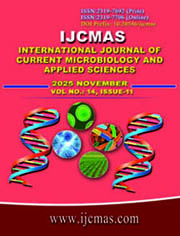


 National Academy of Agricultural Sciences (NAAS)
National Academy of Agricultural Sciences (NAAS)

|
PRINT ISSN : 2319-7692
Online ISSN : 2319-7706 Issues : 12 per year Publisher : Excellent Publishers Email : editorijcmas@gmail.com / submit@ijcmas.com Editor-in-chief: Dr.M.Prakash Index Copernicus ICV 2018: 95.39 NAAS RATING 2020: 5.38 |
This study presents a comparative evaluation of the phytochemical and nutritional constituents of Azadirachta indica (Neem), Phyllanthus emblica (Gooseberry), and Ocimum sanctum (Tulsi) leaves using aqueous and ethanolic extracts. Physical parameters showed notable variation, with Tulsi exhibiting the highest ash content, while Gooseberry demonstrated maximum moisture content. Qualitative phytochemical analysis revealed the presence of alkaloids, flavonoids, phenolics, tannins, saponins, and terpenoids across all samples, with ethanolic extracts yielding higher concentrations of most secondary metabolites. Quantitative profiling confirmed this trend, with Tulsi showing elevated phenolic and flavonoid contents, and Gooseberry exhibiting higher alkaloid and tannin levels in ethanolic extracts. Aqueous extracts were richer in Vitamin C, iron, and magnesium, reflecting the solubility of these constituents in polar solvents. Gooseberry contained the highest Vitamin C, whereas Tulsi had the highest Vitamin E in ethanolic extracts. These findings validate the biochemical diversity of the selected medicinal plants and highlight their relevance as sources of bioactive and nutritional compounds. Although analysed separately, the distinct phytochemical and nutritional profiles suggest potential synergic benefits if formulated together. Overall, this comparative assessment supports the scientific basis for their traditional use and indicates their promise for future nutraceutical and herbal applications.
Baliga, M. S., & Dsouza, J. J. (2011). Amla (Emblica officinalis Gaertn), a wonder berry in the treatment and prevention of cancer. European Journal of Cancer Prevention, 20(3), 225–239. https://doi.org/10.1097/CEJ.0b013e32834473f4
Biswas, K., Chattopadhyay, I., Banerjee, R. K., & Bandyopadhyay, U. (2002). Biological activities and medicinal properties of neem (Azadirachta indica). Current Science, 82(11), 1336–1345.
Brigelius-Flohé, R., & Traber, M. G. (1999). Vitamin E: Function and metabolism. The FASEB Journal, 13(10), 1145–1155. https://doi.org/10.1096/fasebj.13.10.1145
Ghosal, S., Tripathi, V. K., & Chauhan, S. (1996). Active constituents of Emblica officinalis: Part 1—The chemistry and antioxidant effects of two new hydrolysable tannins, emblicanin A and B. Indian Journal of Chemistry, 35B, 941–948.
Gupta, S., Lakshmi, A. J., Manjunath, M. N., & Prakash, J. (2005). Analysis of nutrient and antinutrient content of underutilized green leafy vegetables. Food Science and Technology, 38, 339–345.
Harborne, J. B. (1998). Phytochemical Methods: A Guide to Modern Techniques of Plant Analysis. Springer.
Islas-Flores, I., Gómez-Ortí, D., & Rivera, G. (2022). Neem (Azadirachta indica): A review of its potential as an alternative bioinsecticide. Frontiers in Pharmacology, 13, 891535. https://doi.org/10.3389/fphar.2022.891535
Jamshidi, N., & Cohen, M. M. (2017). The clinical efficacy and safety of Tulsi (Ocimum sanctum) in humans: A systematic review. Evidence-Based Complementary and Alternative Medicine, 2017, 9217567. https://doi.org/10.1155/2017/9217567
Kabata-Pendias, A. (2010). Trace elements in soils and plants (4th ed.). CRC Press.
Kelm, M. A., Nair, M. G., Strasburg, G. M., & DeWitt, D. L. (2000). Antioxidant and cyclooxygenase inhibitory phenolic compounds from Ocimum sanctum Linn. Phytomedicine, 7(1), 7–13.
Khan, K. H. (2009). Roles of Emblica officinalis in medicine – A review. Botany Research International, 2(4), 218–228.
Kharwar, R. N., Mishra, A., Gond, S. K., Stierle, A., & Stierle, D. (2020). Anticancer compounds derived from fungal endophytes: Their importance and future challenges. Natural Product Reports, 37(1), 6–31. https://doi.org/10.1039/C9NP00042F
Levine, M., Rumsey, S. C., Wang, Y., Park, J. B., & Daruwala, R. (1995). Vitamin C. In Present Knowledge in Nutrition (pp. 146–159). ILSI Press.
Marschner, P. (2012). Marschner's mineral nutrition of higher plants (3rd ed.). Academic Press.
Pattanayak, P., Behera, P., Das, D., & Panda, S. K. (2010). Ocimum sanctum Linn. A reservoir plant for therapeutic applications: An overview. Pharmacognosy Reviews, 4(7), 95–105. https://doi.org/10.4103/0973-7847.70902
Prakash, P., & Gupta, N. (2005). Therapeutic uses of Ocimum sanctum Linn (Tulsi) with a note on eugenol and its pharmacological actions: A short review. Indian Journal of Physiology and Pharmacology, 49(2), 125–131.
Scartezzini, P., Antognoni, F., Raggi, M. A., Poli, F., & Sabbioni, C. (2000). Vitamin C content and antioxidant activity of Emblica officinalis Gaertn. Journal of Ethnopharmacology, 71(1–2), 211–216. https://doi.org/10.1016/S0378-8741(99)00189-0
Sofowora, A. (1993). Medicinal plants and traditional medicine in Africa (2nd ed.). Spectrum Books.
Subapriya, R., & Nagini, S. (2005). Medicinal properties of neem leaves: A review. Current Medicinal Chemistry – Anti-Cancer Agents, 5, 149–156. https://doi.org/10.2174/1568011053174828
Trease, G. E., & Evans, W. C. (2002). Pharmacognosy (15th ed.). Saunders Publishers.
Varma, A., Nair, N., & Rawat, P. (2022). Phyllanthus emblica: A comprehensive review of phytochemistry, traditional uses, and pharmacological properties. Antioxidants, 11(5), 816. https://doi.org/10.3390/antiox11050816 |
 |
 |
 |
 |